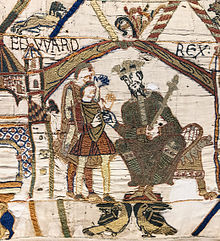
Back Eduard die Belyer Afrikaans Ēadweard Andettere ANG إدوارد المعترف Arabic ادوارد المعترف ARZ Edvard (Atelredin oğlu) Azerbaijani ادوارد خستو AZB Эдуард Спаведнік Byelorussian Едуард Изповедник Bulgarian Edouarzh ar C'hofesour Breton Edvard Ispovjednik BS
| Edward the Confessor | |
|---|---|
 EDWARD(US) REX: Edward the Confessor, enthroned, opening scene of the Bayeux Tapestry | |
| King of the English | |
| Reign | 8 June 1042 – 5 January 1066 |
| Coronation | 3 April 1043 Winchester Cathedral |
| Predecessor | Harthacnut |
| Successor | Harold II |
| Born | c. 1003–1005 Islip, Oxfordshire, England |
| Died | 5 January 1066 (aged 60–63) London, England |
| Burial | Westminster Abbey, London, England |
| Spouse | Edith of Wessex (m. 1045) |
| House | Wessex |
| Father | Æthelred the Unready |
| Mother | Emma of Normandy |
Edward the Confessor[a][b] (c. 1003 – 5 January 1066) was an Anglo-Saxon English king and saint. Usually considered the last king of the House of Wessex, he ruled from 1042 until his death in 1066.
Edward was the son of Æthelred the Unready and Emma of Normandy. He succeeded Cnut the Great's son – and his own half-brother – Harthacnut. He restored the rule of the House of Wessex after the period of Danish rule since Cnut conquered England in 1016. When Edward died in 1066, he was succeeded by his wife's brother Harold Godwinson, who was defeated and killed in the same year at the Battle of Hastings by the Normans under William the Conqueror. Edward's young great-nephew Edgar the Ætheling of the House of Wessex was proclaimed king after the Battle of Hastings, but was never crowned and was peacefully deposed after about eight weeks.
Historians disagree about Edward's fairly long 24-year reign. His nickname reflects the traditional image of him as unworldly and pious. Confessor reflects his reputation as a saint who did not suffer martyrdom as opposed to his uncle, King Edward the Martyr. Some portray Edward the Confessor's reign as leading to the disintegration of royal power in England and the advance in power of the House of Godwin, because of the infighting that began after his death with no heirs to the throne. Biographers Frank Barlow and Peter Rex, on the other hand, portray Edward as a successful king, one who was energetic, resourceful and sometimes ruthless; they argue that the Norman conquest shortly after his death tarnished his image.[1][2] However, Richard Mortimer argues that the return of the Godwins from exile in 1052 "meant the effective end of his exercise of power", citing Edward's reduced activity as implying "a withdrawal from affairs".[3]
About a century after his death, in 1161, Pope Alexander III canonised the king. Edward was one of England's national saints until King Edward III adopted Saint George (George of Lydda) as the national patron saint in about 1350. Saint Edward's feast day is 13 October and is celebrated by both the Church of England and the Catholic Church.
Cite error: There are <ref group=lower-alpha> tags or {{efn}} templates on this page, but the references will not show without a {{reflist|group=lower-alpha}} template or {{notelist}} template (see the help page).
- ^ Barlow 2006.
- ^ Rex 2008, p. 224.
- ^ Mortimer 2009.
© MMXXIII Rich X Search. We shall prevail. All rights reserved. Rich X Search